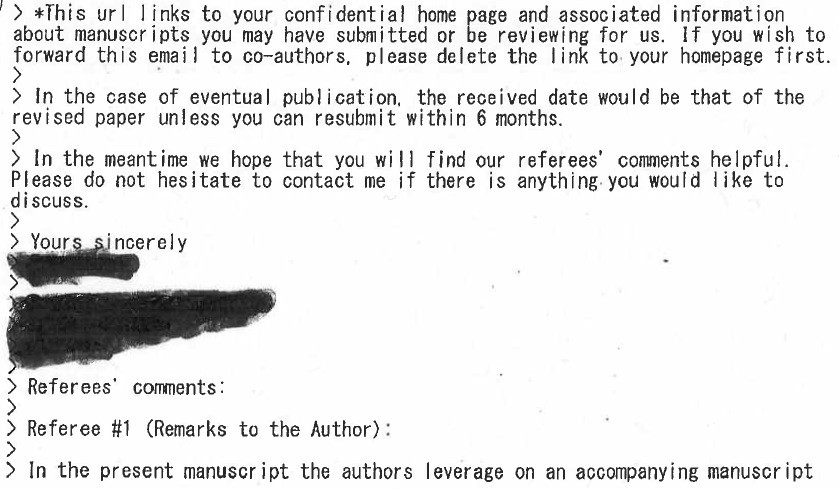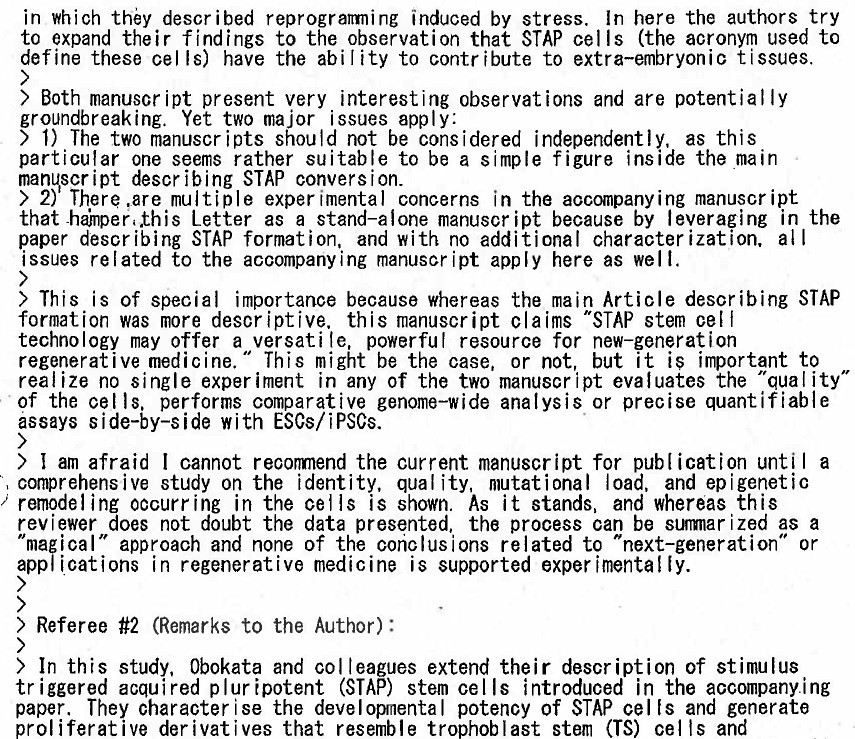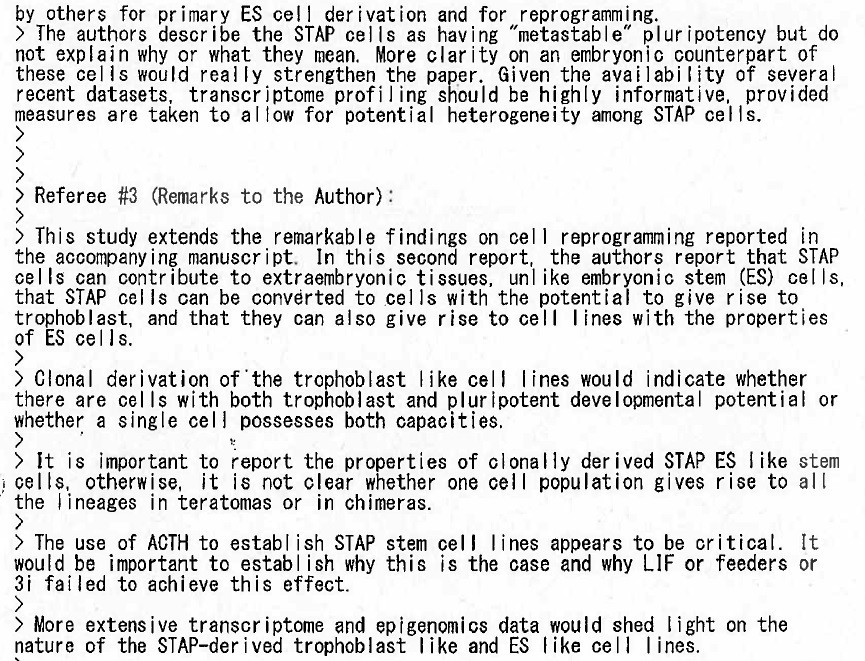博文
还原Science和Nature的STAP论文评审意见
 精选
精选
|||
很有意思的是,小保方晴子的STAP论文先投给Science被拒稿,然后再投给Nature后获准修改后发表。从这一点来看,所谓“同行评审”(peer review)看起来是不客观的,似乎也没有什么公正性可言。
不过,当我仔细阅读过评审意见后,发现一篇文章的命运更大程度上取决于编辑的好恶。比如,Nature评审之一毫不客气地说:“我恐怕不能推荐这篇文章发表”,甚至把文章中采用的方法嘲讽为“魔法”,但编辑却高抬贵手令其畅行无阻。
这使我想起了我们以前一篇论文的命运:明明评审意见都很正面,但责任编辑偏偏越俎代庖,从实验而不是文字上提出各种难以修改的意见,最后迫使本人主动撤稿而放弃发表( 因不满Editor越权,我主动撤稿了!)。
因不满Editor越权,我主动撤稿了!)。
尽管Nature的两篇STAP论文都已由作者主动申请撤销了,但它们给Nature留下的污点是不言而喻的,而在此过程中Nature自始至终坚持评审过程没有丝毫问题。如今这些评审意见的曝光难道不是给了他们一记响亮的耳光吗?
Science编辑回信及评审意见
谢谢你将“胁迫改变的能形成胚胎的体细胞”一文投给Science! 我们现在已收到对你论文的详细评审意见。遗憾的是,他们都未正面支持该文在Science上发表。尽管我们认为你可以在修改文章时处理好其中的多数意见,但从评审意见的总体来看,该文似乎不能挤进我们有限的版面。我们希望这些评述会对你修改文章投给其他杂志有帮助。
21 August 2012
Dr. Haruko Obokata
Anesthesiology
[ROOM NUMBER REDACTED]
Brigham and Womens Hospital/Harvard Medical School
75 Francis Street
Boston MA 02115
USA
Dear Dr. Obokata:
Manuscript number: [REDACTED]
Thank you for submitting your manuscript “Stress altered somatic cells capable of forming an embryo” to Science. We have now received the detailed reviews of your paper. Unfortunately they are not positive enough to support publication of the paper in Science. Although we recognize that you could likely address many of these specific criticisms in a revised manuscript, the overall nature of the reviews is such that the paper would not be able to compete for our limited space. We hope that you find the comments helpful in preparing the manuscript for submission to another journal.
We are grateful that you gave Science the opportunity to consider your work.
Sincerely,
NAME REDACTED, Ph.D.
Senior Editor
REVIEWS
Reviewer 1
This paper claims that cells from any somatic tissue can be reprogrammed to a fully pluripotent state by treatment for a few days with weak acid.
This is such an extraordinary claim that a very high level of proof is required to sustain it and I do not think this level has been reached. I suspect that the results are artifacts derived from the following processes: (1) the tendency of cells with GFP reporters to go green as they are dying. (2) the ease of cross contamination of cell lines kept in the same lab.
I believe that the green transformation is indeed due to stress as reporters are often upregulated in stressed or dying cells. But the cells that go green may not be the ones in the later green colonies. I think these are more likely to be ES cells acquired by cross contamination and selected for growth by the B27-LlF medium. This would explain the results on marker expression, promoter demethylation, differentiation, and chimera formation. In Fig.2B and the other RT-PCR studies, it is not stated whether the Y-axis is linear or logarithmic. If it is linear, which seems more likely, then I am very surprised that all of the pluripotency genes measured in the ESC control have virtually the same RNA abundance, which exceeds that of GAPDH.
The claim about all the other tissues being similarly reprogrammed by low pH treatment is truly extraordinary. Much more detail needs to be provided about the nature of the cells and the culture conditions. Otherwise this is simply not credible, since the principal cell type of several of these tissues is postmitotic.
The DNA analysis of the chimeric mice is the only piece of data that does not fit with the contamination theory. But the DNA fragments in the chimeras don’t look the same as those in the lymphocytes. This assay is not properly explained. If it is just an agarose gel then the small bands could be anything. Moreover this figure has been reconstructed. It is normal practice to insert thin white lines between lanes taken from different gels (lanes 3 and 6 are spliced in). Also I find the leading edge of the GL band suspiciously sharp in #2-#5.
Minor points:
1. It is by no means clear that newt cells can revert to “stem cells” (presumably this means pluripotent stem cells). Recent work on newt regeneration has indicated conservation of tissue type in most cases. The Wolf (1895) reference is out of date.
2. p.8 heading: “exposure” not “expose”.
3. The sentence on p.12 line 6 up “mixture …. analyzed” is very confusing.
4. In the Fig. 4 legend it should be made clear which experiments are done with 2N and which with 4N hosts.
On the positive side, I do agree with the authors that the many claims of pluripotent stem cells from adult mammals probably arise from partial reprogramming due to stress followed by selection in culture. But I don’t think such cells often match ESC in pluripotent behavior, especially the ability to form chimeras in 4N hosts.
Reviewer 2
Obokata et aI. describe a novel method for reprogramming somatic cells to a state that possesses many features of pluripotent stem cells. By subjecting C045+ hematopoietic cells to low pH, mechanical trituration, and culture in LlF-B27 medium, ESC-like properties can be induced, including ESG-like levels of Oct4, Sox2, and Nanog mRNA and critically, the potential for germline transmission and tetraploid complementation — two of the most stringent functional assays for the re-acquisition of pluripotency. If these data are indeed robust then the observation is highly significant.
Unfortunately, the paper presents only a superficial description of many critical aspects of the work. A detailed description of the methods used to induce and maintain SACs was not provided, and the mechanisms and explanations are either not compelling or poorly defined (Figure 3). Given the novelty of the claims, a thorough characterization of the SACs is warranted. as is some probing of the mechanisms. This would necessitate a more sophisticated genomic analysis of SACs, through microarray or RNA-seq, and genome-wide DNA methylation analysis — analyses that other pluripotent stem cell lines have been routinely subjected to and for which methods for smaller cell numbers have been developed.
Issues to be addressed:
1) From the experiments performed by the authors, it cannot be ruled out that rare multipotent progenitors are being selected for and expanded under stress conditions. While this in itself would be extremely interesting, it suggests a very concept [sic] than what is being claimed about reprogramming of “mature” adult somatic populations. It is unclear whether cells are harvested from any other stages than young (7-day old) mice. Might the cells in these young mice be errant migratory germ cells or some other stem cell-like progenitors? CD45+ cells are harvested from the spleens and these are called lymphocytes, but hematopoietic stem cells (HSCs) express CD45, and the spleen contains HSCs at this young age. Thus stress conditions may be acting on HSCs, rather than fully differentiated somatic cells, which would imply a very different main conclusion of this work. Should the authors wish to maintain their conclusion, they should rule out the potential germ cell or HSC origin of SACs. This could involve perhaps the examination of genomic imprints, or expression of c-Kit.
2) The analysis of TCRb gene rearrangement in fig S6 purporting to show derivation from fully mature T cells with TCRb rearrangement is flawed. If mice are clonally derived, they should have a single gene rearrangement, not a population of polyclonal rearrangements as appears in at least some of these animals. This analysis should be done using Southern Blots to avoid the problems of PCR contamination; see Hochedlinger and Jaenisch, Nature 2002.
3) The evaluations of stress-mediated response pathways and analysis of mitochondria are purely correlative and have no demonstrated mechanistic link to the observed reprogramming.
4) The ability to permanently maintain these cell lines is not well-described. The authors claim that “spherical colonies grew to approximately 70 um in diameter … and spherical colonies could be maintained for another 7 days in that culture condition.” Figure 2C–it appears that the expression of mESC-associated pluripotency genes is decreasing significantly over time in bulk SAC populations. If these cells are truly pluripotent. they should not only exhibit the developmental potential of ESCs/iPSCs but also the ability to indefinitely self•renew. For ESCs/iPSCs, past groups provided evidence of telomerase activity to indicate the capture of an immortalized cell line. In the case that the cells cannot self-renew indefinitely, a description of what happens (differentiation, death, etc.), and an explicit statement on unlimited or limited proliferative potential of the SACs should be provided.
5) Reprogramming efficiency alter stress exposure should be monitored for each cell population. Presumably many cells die after low pH treatment, and the 40% of surviving cells expressing Oct4-GFP after 7 days represents a selected and subsequently expanded population, but this is not clear. This would help understand the proportion and give clues to the nature of the cells undergoing reprogramming. For example, more refined cell isolation followed by analysis of conversion efficiency could be very informative.
6) The nature of the B27 medium was not described. Is it serum-free or serum-containing? What is the base medium used? These are critical details because “B27 medium” is not a conventional condition for mouse ESC/iPSC propagation. but rather for primitive neural stem cell derivation/propagation. For serum-free culture of mouse ESCs/iPSCs in LlF and B27 supplement, they require N2 supplement and BMP4 or N2 supplement and 3i/2i (Ying et al. Cell. 2003; Ying et al. Cell. 2008). The original work that first describes the use of LlF-B27 medium was not cited (Tropepe et al. Neuron. 2001). In that study, they critically observed that LlF-B27 ESC-derived neural colonies are competent to colonize both neural and non-neural when exposed to an appropriate environment Given the claim of acquired pluripotency, the authors need to rule out that they have generated primitive neural stem cells by genomic characterization of the SACs they generated, and more precisely capture the nature of the “reprogramming” that is claimed (microarray, DNA methylation analysis, etc.). A systematic genome-wide characterization of SACs will establish the molecular identity of SACs in relation to other mouse pluripotent stem cell lines.
7) From the FACS analysis of Oct4 expression in day 1 CD45+ cells, it is not clear if there is a small population of weakly-expressing Oct4-GFP cells. How can the expansion of a pre-existing Qct4-GFP expression population be ruled out, rather than de novo expression from mature cells? Because the authors claim a significant increase in efficiency and pace of Oct4 locus reactivation, they should compare their method with the predominantly established method by which hematopoietic cells are reprogrammed: by defined factor induction. A head-to-head comparison of SAC induction and iPSC generation is needed (a la Figure 1B).
8) The authors surveyed changes in the mRNA expression levels of an array of stress-response genes, but did not assess their functional relevance by shRNA knockdown or overexpression during conversion.
9) Considering that mouse strains known to be either recalcitrant (e.g. Bl6) or permissive (e.g. 129) to ESC derivation were used in this study, was there any correlation between SAC derivation and strain?
10) It is stated that there was no differentiation tendency of SACs derived from any tissues when incorporated into chimeras. This does not appear to be true as liver-derived SACs exhibit a low contribution, and are skewed to liver differentiation. Similarly, skin-derived SACs appear to demonstrate a tendency to contribute to the skin.
11) Embryos generated by tetraploid complementation should be taken to term. In figure S5E, the example of the BDF1/GFP embryo presented does not look normal.
12) Regarding the existing molecular data on the identity of the cell lines, the embryonic gene expression qPCRs (Figure 2B, S3C) show unusually high values for expression levels relative to GAPDH levels. Even though the figure has an ESC control, and it may be a primer-specific phenomenon, mRNA levels of genes such as Nanog and Rex1 are more like 0.05 or 0.15 of GAPDH levels, whereas the authors observed levels as high as 12 -14 times GAPDH.
13) The authors did not describe “the low pH solution (pH5.5)” treatment in detail (Methods). The authors need to provide a detailed description of what the composition of the pH solution was, how long the treatment was, and how the cells were handled.
14) The authors did not describe the substrate used during conversion. Did they use feeders or gelatin? These are the conventional substrates on which pluripotent stem cells are derived and maintained.
15) Because the authors claimed a combination of pH decrease and mechanical stress caused Oct4 reactivation, the authors should show data indicating how the two procedures additively or synergistically promote Oct4-GFP reactivation.
16) Figure S1C — the authors quantified the number of spherical colonies, but they did not provide a normalization. This figure would additionally be significantly enhanced if the authors showed the morphologies of the spherical colonies they are obtaining in the different culture conditions
17) A more detailed description on the composition of the different media tested was not provided (Figure S1C). Additionally, ACTH is not conventionally used for pluripotent stem cell culture. The manuscript would be enhanced if the authors provided an explanation for the use of ACTH.
18) Decreased cellular size is a feature of pluripotent stem cells, but the authors did not include data or a discussion on the ESCs/iPSCs cell size in their examination of cell size (Figure 1D).
19) Figure 2B — the nuclear localization of the Nanog signal in SACs should be very clear, however the staining appears to be non-specific.
20) The authors should refer to the 2007 Cell Stem Cell paper from the Jaenisch lab when discussing reports of the existence of Oct4-expressing pluripotent adult stem cells. Here it was shown that Oct4 gene ablation in adult tissues did not affect regenerative capacity.
21) Figures are often not referred to in order, making the manuscript slightly difficult to follow at times.
Reviewer 3
The finding described in this manuscript is very unusual and unexpected. Under certain circumstances, it appears that a non-physiological non-specific stress can trigger reprogramming of terminally differentiated cells, such that the cells enter a pluripotent stem cell-like state. If these results are repeatable, a paradigm of developmental biology would be changed. Currently, that paradigm is that terminally differentiated states are set and cannot be reset. Although Yamanaka broke this biological rule by overexpressing pluripotency-associated factors, that system is highly artificial. The authors of the present manuscript propose that cells have an intrinsic capacity to reprogram. I found the manuscript to be clearly written and concise, although sometimes mildly unorthodox in terms of literature cited.
However, the methods and cell protocols used must be described in far more detail. For example, the section on Oct4 should state how many cells were sorted and describe the appearance of the cells. Is it possible that rare populations of cells pre-exist or are already apparent on day 1 (thus, what are the “dots” of Fig. 1?). The authors will argue that, indeed, under certain circumstances, they were able to reprogram terminally differentiated cells, and that this was attributable to TCR recombination. I think, ideally, that the cells should be experimentally tagged and traced. This would unequivocally clarify the source of the cells and, further, would exclude the possibility that some cells pre-existed in a pluripotent state.
Critically, it is necessary to determine whether SAC cells can propagate stably in culture and whether such cells can be passaged. CD45.2 cells from the spleen are differentiated and, unless activated by an antigen, are supposed to be in G0. Do these cells re-enter the cell cycle? The cells should be further characterized.
Some negative controls are missing. See Figs. 2A, S3B, S3C, S5A, and S5B. Unstressed cultured cells should be used as negative controls.
In Figs. 3C and D, it would be interesting to see the ATP and ROS levels in both ES and SAC cells.
In Figs. 3C and D, it is apparent that mES cells show rises in ATP and ROS levels, and in mtDNA copy number. These results should be compared to other publications.
In Fig. 2, Nanog is not located in the nucleus. Also, do the authors have data on staining of Oct4 in this experimental context?
Nature编辑回信及评审意见
你的“获得性多能重编码细胞中胚胎与胎盘系的发育潜力”一文已由3位评审看过了,现将他们的意见附在下面。像我们一样,他们认为你的工作很有潜在的意义,但也提出了一些重要的意见。你只有对这些意见作出适当回应后,我们才会考虑在Nature发表。
如果你用新的实验数据处理这些意见,那么我们将很高兴看到你的修改文章(除非差不多的文章被Nature接受或其他杂志已经发表)。我们同意评审者的观点,即这篇“通信”文章与另一篇文章的关联太多,而Nature的每篇论文都必须别具一格。因此,你可以考虑把两篇论文合并。当然,我们在发表时会提供比通常规定的5页更多的版面。
https://blog.sciencenet.cn/blog-281238-828333.html
上一篇:中医之我见(6)辨证论治理论今解
下一篇:STAP新方案出笼,小保方“咸鱼翻身”?





